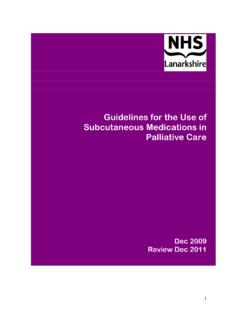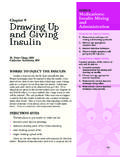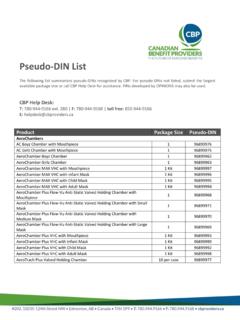Transcription of Guideline for the Administration of Insulin by …
1 Page 1 of 5 Guideline for the Administration of Insulin by Nursing Staff Aims and objectives In Lanarkshire the number of people with Diabetes on Insulin treatment is growing, as both the population ages and people are affected by Diabetes for longer. Within the community setting there are a group of patients who need their injections administered by Registered Nurses as, due to a variety of reasons (poor manual dexterity, lack of strength, mental ability), they are incapable of self-injection. This Guideline provides information and advice on the sub-cutaneous Administration of Insulin to reduce the risk of error in medicines Administration and needlestick injury.
2 This Guideline also seeks to promote safe practice in the use of Insulin PEN devices, which can be used when the traditional method of Insulin syringe and vial is not appropriate. It is recommended that, whenever possible, Insulin must be administered using an Insulin syringe and vial (SAN (SC) 05/10). In the event that the medication prescribed is only available in a pen device (due to the type of Insulin prescribed) the Registered Nurse must ensure they are proficient in the use of the pen. Responsibility for the procedure is with the Registered Nurse.
3 They must ensure that they are competent in the following before undertaking the procedure: Understanding and interpreting an Insulin prescription sheet Drawing up the correct dose of Insulin into an Insulin syringe or correctly using a pen device Knowledge of injection sites Examination of injection sites for lipodystrophy (lumpy areas) Administering a subcutaneous injection Safe disposal of sharps, immediately after use The use of a blood glucose meter to monitor blood glucose and interpretation of the result How to recognise and respond to hyper- or hypoglycaemia Patient/carer communication strategies, with the outcome of increased patient/carer involvement and concordance in all aspects of Diabetes management and decision making Record keeping which complies with the NHS Lanarkshire policies Author(s)
4 Brenda Moran, Diabetes Specialist Nurse Dr Susan Arnott, Diabetes MCN Lead Clinician User group All registered nursing staff who require to administer Insulin All staff involved in the use of Insulin pen devices, or in the education of patients in the use of these devices. Guideline PATIENT CRITERIA Community patients who are experiencing difficulties in drawing up and administering their Insulin on their own should be assessed by community nursing staff and, where appropriate, referred to the Diabetes Specialist Nurse for additional support and assessment.
5 Any changes in the patient s diabetes management should be clearly documented and communicated effectively to all those involved in the care of that individual. Page 2 of 5 Teaching self Administration of Insulin for new Type 1s and Type 2s commencing Insulin therapy within the hospital environment should be undertaken by appropriately trained staff who are fully aware of the working mechanisms of all Insulin devices. NB Being able to self-administer is an essential part of a patient s education and should be carried out under the supervision of trained staff prior to discharge.
6 Administration OF Insulin BY NURSING STAFF Identification of Insulin Is the Insulin available in vials? If yes, follow procedure for Administration of Insulin with Insulin syringes. If the Insulin is not available in vials, ensure that the Insulin has been prescribed for use in the appropriate pre loaded disposable pen listed below and follow procedure for pen use Novomix 30 (Flexpen), Levemir (Flexpen) and Humalog Mix 50 (Kwik Pen) are only available for PEN devices. Where Insulin is to be administered by a Registered Nurse the use of prefilled PEN devices (as detailed in brackets) is preferred for those patients.
7 All have a similar mechanism and are easy to demonstrate and use Note pre-meal analogue Insulin is rapid acting and the person with Diabetes requires to eat immediately after Insulin Administration Never withdraw Insulin from a cartridge or prefilled pen using a needle and Insulin syringe. This contaminates the Insulin and interferes with accurate dose determination using the PEN device The Insulin must never be drawn up in an Insulin syringe or the pen dialled up and stored in advance of the procedure Equipment required U100 disposable Insulin syringe with 8mm needle Vial of Insulin Or Pre loaded Insulin device with appropriate needle Owen Mumford Uniguard Needle Remover (acute sites) or Novofine Needle Remover (community)
8 Sharps box Gloves Blood glucose meter Procedure Ensure prescription is complete, correct, legible and unambiguous prior to Administration Check the name of the Insulin and dose against the Insulin prescription chart in the patient s record Confirm the identity of the patient prior to administering the Insulin Check the Insulin has not already been administered by someone else Wash hands and put on gloves Check the blood glucose level according to NHS Lanarkshire Guideline on blood glucose monitoring and record the result prior to administering the Insulin Check correct storage of Insulin
9 Check expiry date Prepare the Insulin syringe or pen device (see below) Page 3 of 5 Procedure (continued) Select injection site - remember to rotate injection sites, never use the same site for consecutive injections Insulin should be injected into sub-cutaneous tissue or soft fat, not muscle. To avoid intramuscular injection, evidence suggests that raising the skin is best practice and, in some cases, use of a smaller needle will be recommended by the specialist clinician (see below) Continue to raise the skin and hold the Insulin syringe in place for a count of 10 to ensure that the Insulin disperses from the site of the injection Remove the needle and Insulin syringe and dispose as per safe disposal of sharps Record the dose, timing and site of Insulin injection on the chart and initial Report to a supervisor if the patient bleeds from an injection site, Insulin appears at the site of an injection or the patient complains that the injection is painful.
10 If this is the case injection technique may need reassessment NB In the hospital environment, Insulin should be checked by two registered nurses (or nurse and medical practitioner); as this is not possible within the community setting, extra care and vigilance must be practised by the registered nurse when administering Insulin . Preparing Insulin syringe For Neutral Protamine Hagedorn (NPH) and pre mixed Insulin invert the vial of Insulin backwards and forwards and roll gently between your hands approximately 20 times to insure the Insulin is well mixed.














